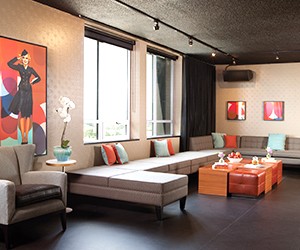Major hotel companies continue to shake up their images with stylish brands that are a significant departure from the traditional full-service hotels for which they are known.
Sometimes called "lifestyle brands," more often "boutique hotels," they fall into segments of the hotel industry that are growing even in the midst of a development slowdown that has put the brakes on many hotel projects.
"Boutique hotels are here to stay," says Scott Berman, hospitality and leisure practice leader for PricewaterhouseCoopers (PwC). "It’s not a passing fad. If you look at demographics, there’s no question; younger travelers prefer a boutique environment."
The boutique brands are difficult to define because they are stretched across several hotel industry segments, including mid-priced, upscale and luxury, and they offer different levels of service and facilities. Even their size can vary widely.
"Boutique by its name suggests something small, but there’s debate in the industry," Berman says. "Is it under 200 rooms? Under 100? No one is wrong."
What is clearer is the concept that unites these properties. Far from "cookie cutter," they offer distinctive character, modern decor, local flavor and a more personal and intimate environment than large, full-service properties. Meeting space is included but it is not a focus.
"They’re not giant square boxes," Berman says.
One of the most eye-catching examples is the new Edition brand, the result of a partnership between Marriott and hip hotelier Ian Schrager, which was launched with the opening of the Waikiki Edition last fall. Marriott has also launched another brand, The Autograph Collection, described as "upscale hotels with distinct personalities," that includes New York’s legendary Algonquin Hotel.
Meanwhile, Starwood is expanding far beyond the 13-year-old upscale W boutique brand with mid-priced entrants Aloft and Element by Westin. Wyndham last year acquired mid-priced boutique operator TRYP from Spain’s Sol Melia. In the same segment, InterContinental is expanding its Indigo Hotels concept, as is Hyatt with Andaz.
At the same time, a number of others are joining the boutique fray: Ace Hotels, Modus Hotels, Sonesta, B Hotels and Resorts and Richard Branson’s Virgin Hotels among them.
Trail Blazer
This year marks the 30th anniversary for Kimpton Hotels, which is credited with starting the boutique phenomenon. In 1981, the late Bill Kimpton opened the Clarion Bedford Hotel in San Francisco, transforming an aging downtown building into a small European-style hotel.
San Francisco hotelier Chip Conley modeled Joie de Vivre Hospitality after Kimpton, also taking over city center buildings and turning them into distinctive themed properties. Last year, Conley, who amassed an eclectic collection of more than 30 California hotels, sold a controlling interest in JDV to Hyatt heir John Pritzker, who plans to expand JDV beyond the West Coast.
Major hotel companies have been playing catch-up, notes Robert Mandelbaum, director of research information for PKF Hospitality Research.
"The way that Kimpton and Joie di Vivre operated was with nontraditional, out-of-the-box thinking, and there was almost immediate consumer appeal," he says. "The chains were motivated by their success.
"If you’re a Marriott or Starwood, you have a lot of franchise brands and most markets are full with those brands," he continues. "In order to grow you need new products. They saw that boutiques were popular. They needed these new types of products."
According to Mandelbaum, once a major chain starts a boutique brand, competitors are likely to follow suit.
"Generally, the hotel industry is an industry of followers," he says.
Economic Sense
The economics of boutique hotels, particularly "select service" brands with limited food and beverage and other facilities, also make sense for hotel developers.
"Without a lot of public space and food and beverage, development costs go down," Mandelbaum says. "They become deals that are financeable and doable. Full-service hotels with restaurants and large amounts of meeting space are becoming a thing of the past. You’re seeing growth of smaller hotels with limited service and full-service convention hotels. What’s losing out is the traditional mid-market full-service hotel."
PwC’s Berman agrees, adding that "you can run these boutique properties without significant operating expenses. In the more upscale, full-service hotels, you’ve got to have more restaurants and many other facilities. You have greater expenses and need to drive more revenue to support those expenses."
Another financial incentive is that many of the boutiques are conversions from existing buildings, eliminating the need to finance land acquisition.
"They often cost less to build because there isn’t the cost of land in new builds," Berman says. "The cost of converting an existing building to a hotel is less [than a new build] and financing is more readily available."
Starwood’s Aloft has been the fastest brand launch in hotel industry history, and most are new builds. Some 50 Alofts have opened worldwide since the first was unveiled three years ago.
"We launched Aloft to reinvent the select service market by showing guests that they don’t have to sacrifice style or a dynamic, social experience to get a good price," says Paige Francis, Starwood’s vice president of marketing for specialty select brands.
Each Aloft has at least one boardroom, called Tactic, with the latest in audiovisual equipment and other technology. Some properties have several boardrooms and additional function space.
TRYP Time
At Wyndham, TRYP is designed as a mid-priced, select-service brand with a focus on personalized service and a vibrant atmosphere to appeal to a younger generation of travelers. The first U.S. TRYP is scheduled to open in New York City in July.
"Our research has found that the younger travelers are looking for experiences that are anti-cookie cutter," says Daniel del Olmo, TRYP’s brand senior vice president. "They are not as brand loyal as Baby Boomers and they are looking for the right experience and right location instead of a particular brand."
TRYP focuses on conversions of buildings in city centers with international business.
"Many are re-adaptations of historic buildings," del Olmo says. "We want our guests to have an experience of not only the city but the neighborhood."
For Wyndham, an advantage is operating efficiency.
"In select-service, you basically get the experience of a higher-priced property but you can run it without significant operating expenses," del Olmo says. "The food and beverage is integrated. There’s no separation of the lobby with the bar and restaurant, for example, so you can run a very lean organization and cross-utilize staff from the lobby for the bar and still deliver a superior guest experience."
New Edition
In the more upscale segment, Marriott is steering away from the using the word "boutique" for the Ian Schrager-designed Edition hotels. The company, which acquired the Seville Hotel in Miami Beach and the historic Berners Hotel in London to redevelop into Edition hotels in the next two years, prefers "luxury lifestyle," says Kate Harth, Edition’s vice president of sales.
"These are properties that are unique and true to the destination, with the Marriott brand behind it and the exposure and scale that that brings to the marketplace," she says.
According to Harth, Edition, which is positioned with a price point "slightly lower" than Marriott’s Ritz-Carlton brand, is "about excitement," with the aim to have the social venues the "hottest spots at a destination for tourists and locals." Meeting space will vary, depending on the property; in Waikiki, for instance, the Edition offers a 9,200-square-foot ballroom that it promotes as the "largest luxury event space on Oahu."
Mood Indigo
At InterContinental Hotel Group, the rapidly expanding Hotel Indigo brand differentiates itself from the company’s other brands with lower room rates and "a local experience," says Mary Dogan, director of brand management.
"At our hotel in Chelsea, you’re not in a New York hotel but a hotel that’s about Chelsea and the fashion and flower district," she says. "We are focusing on fresh and vibrant designs. The price point is in the upscale, but not upper upscale, which is where InterContinentals are."
As with the other hotel companies’ boutique brands, Indigo’s meeting space is designed for small meetings, with all having at least one boardroom.
"The key demographics are travelers 35 to 54, a split between business and leisure," Dogan says. "It skews married with no children and household incomes $75,000 plus. These people are definitely affluent and they are looking for more of a local experience."
Hotel companies acknowledge that some of the new brands may take business away from a company’s more established names but they say the new brands are about enlarging their customer base, attracting guests who prefer smaller, independent hotels—and making sure they don’t lose loyal guests to competitors.
"In theory, if you’re staying at the big Westin in a city you will not stay at one of the cutesy smaller hotels and vice versa," PKF’s Mandelbaum says. "There’s always angst among the franchisees in terms of encroachment, even with brands in the same company. But from a franchisor standpoint, it’s better to keep guests in the system than have them go to the new competitor."
Laura Del Rosso has written for travel industry magazines for over 20 years and is the author of Great Escapes: Northern California.






